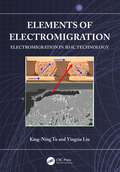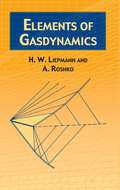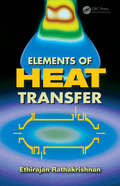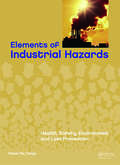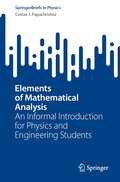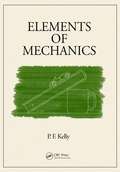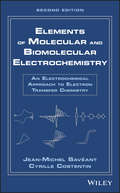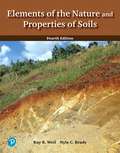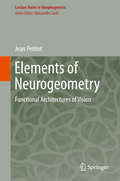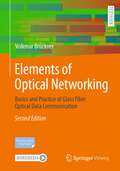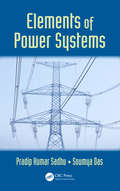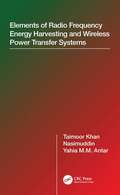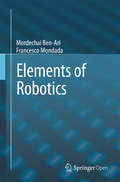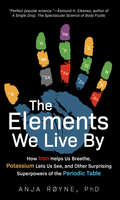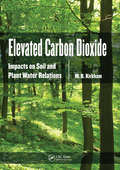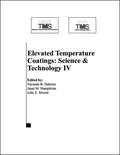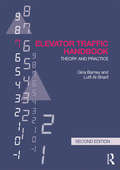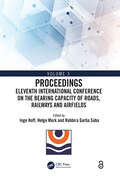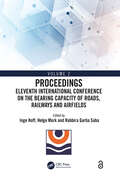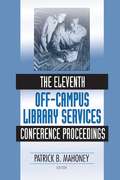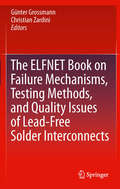- Table View
- List View
Elements of Electromigration: Electromigration in 3D IC technology
by King-Ning Tu Yingxia LiuIn this invaluable resource for graduate students and practicing professionals, Tu and Liu provide a comprehensive account of electromigration and give a practical guide on how to manage its effects in microelectronic devices, especially newer devices that make use of 3D architectures. In the era of big data and artificial intelligence, next-generation microelectronic devices for consumers must be smaller, consume less power, cost less, and, most importantly, have higher functionality and reliability than ever before. However, with miniaturization, the average current density increases, and so does the probability of electromigration failure. This book covers all critical elements of electromigration, including basic theory, various failure modes induced by electromigration, methods to prevent failure, and equations for predicting mean-time-to-failure. Furthermore, effects such as stress, Joule heating, current crowding, and oxidation on electromigration are covered, and the new and modified mean-time-to-failure equations based on low entropy production are given. Readers will be able to apply this information to the design and application of microelectronic devices to minimize the risk of electromigration-induced failure in microelectronic devices. This book essential for anyone who wants to understand these critical elements and minimize their effects. It is particularly valuable for both graduate students of electrical engineering and materials science engineering and engineers working in the semiconductor and electronic packaging technology industries.
Elements of Friction Theory and Nanotribology
by Enrico Gnecco Ernst MeyerCombining the classical theories of contact mechanics and lubrication with the study of friction on the nanometer range, this multi-scale book for researchers and students alike guides the reader deftly through the mechanisms governing friction processes, based on state-of-the-art models and experimental results. The first book in the field to incorporate recent research on nanotribology with classical theories of contact mechanics, this unique text explores atomic scale scratches, non-contact friction and fishing of molecular nanowires as observed in the lab. Beginning with simple key concepts, the reader is guided through progressively more complex topics, such as contact of self-affine surfaces and nanomanipulation, in a consistent style, encompassing both macroscopic and atomistic descriptions of friction, and using unified notations to enable use by physicists and engineers across the scientific community.
Elements of Gas Dynamics (Dover Books on Aeronautical Engineering)
by A. Roshko H. W. LiepmannThe increasing importance of concepts from compressible fluid flow theory for aeronautical applications makes the republication of this first-rate text particularly timely. Intended mainly for aeronautics students, the text will also be helpful to practicing engineers and scientists who work on problems involving the aerodynamics of compressible fluids. Covering the general principles of gas dynamics to provide a working understanding of the essentials of gas flow, the contents of this book form the foundation for a study of the specialized literature and should give the necessary background for reading original papers on the subject. Topics include introductory concepts from thermodynamics, including entropy, reciprocity relations, equilibrium conditions, the law of mass action and condensation; one-dimensional gasdynamics, one-dimensional wave motion, waves in supersonic flow, flow in ducts and wind tunnels, methods of measurement, the equations of frictionless flow, small-perturbation theory, transonic flow, effects of viscosity and conductivity, and much more. The text includes numerous detailed figures and several useful tables, while concluding exercises demonstrate the application of the material in the text and outline additional subjects. Advanced undergraduate or graduate physics and engineering students with at least a working knowledge of calculus and basic physics will profit immensely from studying this outstanding volume.
Elements of Heat Transfer
by Ethirajan RathakrishnanWritten for chemical, mechanical, and aerospace engineering students taking courses on heat and mass transfer, this textbook presents the basics and proceeds to the required theory and its application aspects. Major topics covered include conduction, convection, radiation, boiling, heat exchangers, and mass transfer and are explained in a detailed,
Elements of Industrial Hazards: Health, Safety, Environment and Loss Prevention
by Ratan Raj TatiyaAn introductory course on Health, Safety and Environment (HSE) as applicable to all manufacturing and exploration engineering industries. Its first part deals with fundamentals, ecology and environmental engineering and covers air and water pollution sources, magnitude, measuring techniques and remedial measures to minimize them. The second pa
Elements of Mathematical Analysis: An Informal Introduction for Physics and Engineering Students (SpringerBriefs in Physics)
by Costas J. PapachristouThis book provides a comprehensive yet informal introduction to differentiating and integrating real functions with one variable. It also covers basic first-order differential equations and introduces higher-dimensional differentiation and integration. The focus is on significant theoretical proofs, accompanied by illustrative examples for clarity. A comprehensive bibliography aids deeper understanding. The concept of a function's differential is a central theme, relating to the "differential" within integrals. The discussion of indefinite integrals (collections of antiderivatives) precedes definite integrals, naturally connecting the two. The Appendix offers essential math formulas, exercise properties, and an in-depth exploration of continuity and differentiability. Select exercise solutions are provided. This book suits short introductory math courses for novice physics/engineering students. It equips them with vital differential and integral calculus tools for real-world applications. It is also useful for first-year undergraduates, reinforcing advanced calculus foundations for better Physics comprehension.
Elements of Mechanics
by P.F. KellyThe first volume in a three-part series, Elements of Mechanics provides a rigorous calculus-based introduction to classical physics. It considers diverse phenomena in a systematic manner and emphasises the development of consistent and coherent models guided by symmetry considerations and the application of general principles. Modern developments c
Elements of Molecular and Biomolecular Electrochemistry: An Electrochemical Approach to Electron Transfer Chemistry (Baker Lecture Ser. #13)
by Jean-Michel Savéant Cyrille CostentinWritten by two of the world's leading authorities in the field of electrochemistry, this book comprehensively addresses workhorse electrochemical reactions that serve as the basis of modern research for alternative energy solutions. Provides an accessible and readable summary on the use of electrochemical techniques and the applications of electrochemical concepts to functional molecular-level systems Includes a new chapter on proton coupled electron transfer, a completely revamped chapter on molecular catalysis of electrochemical reactions, and added sections throughout the book Bridges a gap and strengthens the relationship between electrochemists, molecular and biomolecular chemists—showing a variety of functions that may be obtained by multi-component systems designed using the paradigms of both chemistries
Elements Of The Nature And Properties Of Soils
by Nyle Brady Raymond WeilAt the forefront of soil science for over a century, Elements of the Nature and Properties of Soils considers the role of soils as both a natural resource and an ecosystem, while highlighting interactions between soils and other components of natural and constructed ecosystems. With practical value for meeting today’s environmental challenges, the text asserts that balancing economic growth with sustainable economies requires a deep understanding of soils. The 4th edition has been abridged to focus on fundamentals, while providing new or updated discussions on topics such as soils and human health, organic farming, and soil food-web ecology.
Elements of Neurogeometry
by Jean PetitotThis book describes several mathematical models of the primary visual cortex, referring them to a vast ensemble of experimental data and putting forward an original geometrical model for its functional architecture, that is, the highly specific organization of its neural connections. The book spells out the geometrical algorithms implemented by this functional architecture, or put another way, the "neurogeometry" immanent in visual perception. Focusing on the neural origins of our spatial representations, it demonstrates three things: firstly, the way the visual neurons filter the optical signal is closely related to a wavelet analysis; secondly, the contact structure of the 1-jets of the curves in the plane (the retinal plane here) is implemented by the cortical functional architecture; and lastly, the visual algorithms for integrating contours from what may be rather incomplete sensory data can be modelled by the sub-Riemannian geometry associated with this contact structure. As such, it provides readers with the first systematic interpretation of a number of important neurophysiological observations in a well-defined mathematical framework. The book's neuromathematical exploration appeals to graduate students and researchers in integrative-functional-cognitive neuroscience with a good mathematical background, as well as those in applied mathematics with an interest in neurophysiology.
Elements of Optical Networking: Basics and Practice of Glass Fiber Optical Data Communication
by Volkmar BrücknerThis compact textbook introduces the most important elements of optical networks and uses them to solve practical problems by engineering solutions. The main topics are glass fibers, optical transmitters and receivers, modulation of laser light for high bit rates, elements of passive (couplers, distributors) and active (switches, optical amplifiers) networks, influence of nonlinearities in optical transmission as well as integration into the global network. Examples describe advantages and limits of optical data transfer in networks. In addition to each topic, practical exercises and questions are given. Difficult mathematical relationships and formulas are explained and simulated using a mathematical program.This textbook has been recommended and developed for university courses in Germany, Austria and Switzerland.The contentPhotonics, wave-guide structures, glass fibers – Parameters and properties of optical fibers: attenuation and dispersion, transmission bandwidth – Optical transmitters, modulation of transmitters – Optical amplifiers – Optical receivers – Active and passive optical couplers and switches – Nonlinear processes in glass fibers, solitons – Active and passive optical networksTarget GroupsStudents of Bachelor and Master courses at Universities of Applied SciencesStudents of Bachelor courses at Technical UniversitiesPractitioners in the fields of telecommunications and communication technologyLife-long learners
Elements of Power Systems
by Pradip Kumar SadhuElements of Power Systems prepares students for engineering degrees, diplomas, Associate Member of the Institution of Engineers (AMIE) examinations, or corresponding examinations in electrical power systems. Complete with case studies, worked examples, and circuit schematic diagrams, this comprehensive text:Provides a solid understanding of the the
Elements of Radio Frequency Energy Harvesting and Wireless Power Transfer Systems
by Taimoor Khan Nasimuddin Yahia M.M. AntarThis book focuses on elementary concepts of both radio frequency energy harvesting (RFEH) and wireless power transfer (WPT), and highlights their fundamental requirements followed by recent advancements. It provides a systematic overview of the key components required for RFEH and WPT applications and also comprehensively introduces the pioneering research advancements achieved to date. The state-of-the-art circuit design topologies for the two different applications are presented mainly in terms of antenna operating frequencies, polarization characteristics, efficient matching network circuits, rectifier topologies, and overall rectenna systems. The book serves as a single point of reference for practicing engineers and researchers searching for potential sources and elements involved in the RFEH system as well as in the WPT system, and need rapid training and design guidelines in the following areas: • Different sensing elements used in RFEH and WPT • Inclusions of mathematical expressions and design problems • Illustration of some design examples and performance enhancement techniques
Elements of Robotics
by Mordechai Ben-Ari Francesco MondadaThis book is open access under a CC BY 4. 0 license. This book bridges the gap between playing with robots in school and studying robotics at the upper undergraduate and graduate levels to prepare for careers in industry and research. Robotic algorithms are presented formally, but using only mathematics known by high-school and first-year college students, such as calculus, matrices and probability. Concepts and algorithms are explained through detailed diagrams and calculations. Elements of Robotics presents an overview of different types of robots and the components used to build robots, but focuses on robotic algorithms: simple algorithms like odometry and feedback control, as well as algorithms for advanced topics like localization, mapping, image processing, machine learning and swarm robotics. These algorithms are demonstrated in simplified contexts that enable detailed computations to be performed and feasible activities to be posed. Students who study these simplified demonstrations will be well prepared for advanced study of robotics. The algorithms are presented at a relatively abstract level, not tied to any specific robot. Instead a generic robot is defined that uses elements common to most educational robots: differential drive with two motors, proximity sensors and some method of displaying output to the user. The theory is supplemented with over 100 activities, most of which can be successfully implemented using inexpensive educational robots. Activities that require more computation can be programmed on a computer. Archives are available with suggested implementations for the Thymio robot and standalone programs in Python.
Elements of Rock Physics and Their Application to Inversion and AVO Studies
by Robert S. Gullco Malcolm AndersonThe ultimate aim of the oil exploration industry is to determine the distribution of rock types and underground fluids. At this stage, we can actually determine the distribution of several underground physical properties with a certain accuracy. The challenge for the rock physicist is to translate those physical properties (P-velocity, S-velocity, density) into rock types and fluids (gas-, or oil-, or water-bearing sand, shale). If performed correctly, dry holes can be avoided and millions of dollars can be saved. Ultimately, an integrated approach is required. This book deals with a series of topics in rock physics, including elasticity, pore pressure, incompressibility of rocks and the Gassmann equation, fluid substitution, forward modelling and empirical equations, rock physics applications to AVO studies and inversion studies, and the Differential Effective Medium (DEM) method. It is generally addressed to the practitioner (geophysicist, geologist), and in some instances, detailed instructions are furnished to perform a particular task. Some chapters, on the other hand, are theoretical and more mathematical, and are expected to be of interest to both practitioners and students alike. Other chapters include innovative ideas that could, for instance, be tested by oil companies that have substantial amounts of data at their disposal. This book will serve as a useful guide to practitioners (geologists, petrophysicists, geophysicists and reservoir engineers) and students/academics.
The Elements We Live By: How Iron Helps Us Breathe, Potassium Lets Us See, and Other Surprising Superpowers of the Periodic Table
by Anja RøyneThis “excellent” popular science book explores just what we—and the things around us—are made of (Aftenposten, Norway).Some elements get all the attention: glittering gold, radioactive uranium—materials we call “precious” because they are so rare. But what could be more precious than the building blocks of life—from the oxygen in our air to the carbon in all living things?In The Elements We Live By, physicist and award-winning author Anja Røyne reminds us that we’d be lost without the quiet heroes of the periodic table. Our bodies need phosphorous to hold our DNA together, potassium to power our optic nerves, and many more elements—in just the right amounts—to function. Other fundamental elements keep our technology (and society) running: Our phones contain arsenic, boron, and gallium to control signals and store information; indium and tin for the touch screen; and lithium for the battery.Everything is made of elements—every galaxy, star, and planet—from the iron in Earth’s core to the silicon in its sand. But that doesn’t mean the elements we rely on will never run out; for example, about half the lithium we need is extracted from rocks in Australia, and the other half is from saltwater in Argentina and Chile. As Røyne travels the world to find where these elements exist (some in ever-shrinking amounts), she shows how vitally urgent it is for us to protect them—the elements of our very existence.“Not just a discussion of basic chemistry, this is a volume that looks at the human impact on the planet and what we can learn from nature…Useful for science or sociology courses that address the various impacts of natural resource development or for popular science readers.” —School Library Journal
The Elephant Moon of Sir Herbert Spoon
by Kelly TerwilligerSir Herbert Spoon alerts Cecil Spout, his butler, that he has spotted an elephant on the moon through his telescope.
Elevated Carbon Dioxide: Impacts on Soil and Plant Water Relations
by M.B. KirkhamBetween 1958 and 2008, the CO2 concentration in the atmosphere increased from 316 to 385 ppm. Continued increases in CO2 concentration will significantly affect long-term climate change, including variations in agricultural yields. Focusing on this critical issue, Elevated Carbon Dioxide: Impacts on Soil and Plant Water Relations presents research
Elevated Temperature Coatings
by Janet M. Hampikian Narendra B. Dahorte John E. MorralThis conference proceedings focuses on processing and characterizing high-temperature coatings with regard to engineering, physical, and chemical properties. It includes the synthesis of new and unconventional coating materials and addresses various existing methods along with novel and innovative techniques of producing coatings and their applications.
Elevator Traffic Handbook: Theory and Practice
by Gina Barney Lutfi Al-SharifThis second edition of this well-respected book covers all aspects of the traffic design and control of vertical transportation systems in buildings, making it an essential reference for vertical transportation engineers, other members of the design team, and researchers. The book introduces the basic principles of circulation, outlines traffic design methods and examines and analyses traffic control using worked examples and case studies to illustrate key points. The latest analysis techniques are set out, and the book is up-to-date with current technology. A unique and well-established book, this much-needed new edition features extensive updates to technology and practice, drawing on the latest international research.
Eleventh International Conference on the Bearing Capacity of Roads, Railways and Airfields: Volume 1
by Inge HoffInnovations in Road, Railway and Airfield Bearing Capacity – Volume 1 comprises the first part of contributions to the 11th International Conference on Bearing Capacity of Roads, Railways and Airfields (2022). In anticipation of the event, it unveils state-of-the-art information and research on the latest policies, traffic loading measurements, in-situ measurements and condition surveys, functional testing, deflection measurement evaluation, structural performance prediction for pavements and tracks, new construction and rehabilitation design systems, frost affected areas, drainage and environmental effects, reinforcement, traditional and recycled materials, full scale testing and on case histories of road, railways and airfields. This edited work is intended for a global audience of road, railway and airfield engineers, researchers and consultants, as well as building and maintenance companies looking to further upgrade their practices in the field.
Eleventh International Conference on the Bearing Capacity of Roads, Railways and Airfields: Volume 3
by Inge HoffInnovations in Road, Railway and Airfield Bearing Capacity – Volume 3 comprises the third part of contributions to the 11th International Conference on Bearing Capacity of Roads, Railways and Airfields (2022). In anticipation of the event, it unveils state-of-the-art information and research on the latest policies, traffic loading measurements, in-situ measurements and condition surveys, functional testing, deflection measurement evaluation, structural performance prediction for pavements and tracks, new construction and rehabilitation design systems, frost affected areas, drainage and environmental effects, reinforcement, traditional and recycled materials, full scale testing and on case histories of road, railways and airfields. This edited work is intended for a global audience of road, railway and airfield engineers, researchers and consultants, as well as building and maintenance companies looking to further upgrade their practices in the field.
Eleventh International Conference on the Bearing Capacity of Roads, Railways and Airfields: Volume 2
by Inge HoffInnovations in Road, Railway and Airfield Bearing Capacity – Volume 2 comprises the second part of contributions to the 11th International Conference on Bearing Capacity of Roads, Railways and Airfields (2022). In anticipation of the event, it unveils state-of-the-art information and research on the latest policies, traffic loading measurements, in-situ measurements and condition surveys, functional testing, deflection measurement evaluation, structural performance prediction for pavements and tracks, new construction and rehabilitation design systems, frost affected areas, drainage and environmental effects, reinforcement, traditional and recycled materials, full scale testing and on case histories of road, railways and airfields. This edited work is intended for a global audience of road, railway and airfield engineers, researchers and consultants, as well as building and maintenance companies looking to further upgrade their practices in the field.
The Eleventh Off-Campus Library Services Conference Proceedings
by Patrick MahoneyLearn how to provide better service to distance information users! This book is the result of the conference held in May, 2004 in Scottsdale, Arizona, focusing on librarians' challenges providing service to nontraditional faculty and students. Respected authorities discuss in detail specific problems-and fresh strategies and solutions-to further promote service to distance information users. Each chapter tackles a particular issue such as collaboration outside the contributor's organization or how services can be monitored and assessed to gauge quality, and fully explains what can be done to address those issues. Each distinguished contribution was carefully selected by a 26-member advisory board using a juried abstracts process. Thorough bibliographies, useful figures, tables, and graphs provide accessibility and clarify ideas. Some of the topics in this book include: the promotion of library services to Native American students the planning and development process of a project to create a Web-based multi-media instruction tool for off-campus graduate students an examination of direct linking tools provided by major aggregators distance learning for the learning disabled distance learning implementation strategies for institutions course management software (CMS) and library services integration a survey of Association of Research Libraries offered services the do&’s and don&’ts of videoconferencing on and off-campus an eBooks collection study one-on-one research coaching via digital reference service an online tool that assesses students&’ research skills and attitudes creating a library CD for off-campus students expanding student and faculty access to information services the collaboration with faculty on electronic course reserves developing assessment questions for services supporting off-campus learning programs providing secure off-campus access to library services beyond proxy servers and much, much more!The Eleventh Off-Campus Library Services Conference Proceedings is an invaluable comprehensive resource detailing the latest challenges and solutions for on- and off-campus librarians.
The ELFNET Book on Failure Mechanisms, Testing Methods, and Quality Issues of Lead-Free Solder Interconnects
by Günter Grossmann Christian ZardiniThe ELFNET Book on Failure Mechanisms, Testing Methods, and Quality Issues of Lead-Free Solder Interconnects is the work of the European network ELFNET which was founded by the European Commission in the 6th Framework Programme. It brings together contributions from the leading European experts in lead-free soldering.The limited validity of testing methods originating from tin-lead solder was a major point of concern in ELFNET members' discussions. As a result, the network's reliability group decided to bring together the material properties of lead-free solders, as well as the basics of material science, and to discuss their influence on the procedures for accelerated testing. This has led to a matrix of failure mechanisms and their activation and, as a result, to a comprehensive coverage of the scientific background and its applications in reliability testing of lead-free solder joints.The ELFNET Book on Failure Mechanisms, Testing Methods, and Quality Issues of Lead-Free Solder Interconnects is written for scientists, engineers and researchers involved with lead-free electronics.
